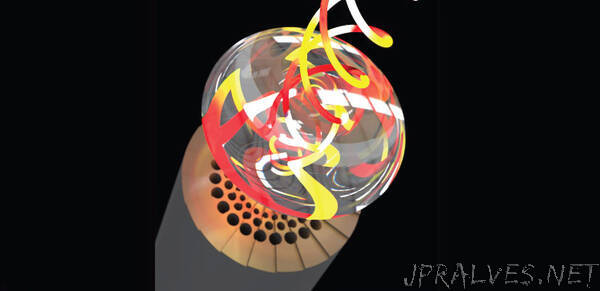
“Fabricating intricate optical structures onto the tip of an optical fiber creates a new source of special light beams.
An all fiber-based approach to generating special optical beams, called Bessel beams, could open up new applications in imaging, optical trapping and communications.
Bessel beams look quite different from the usual Gaussian light beams found in optics. In particular, they possess several interesting properties including self-healing, diffraction-free propagation and the ability to carry orbital angular momentum (OAM). This family of beams — also known as vortex beams with a characteristic ring-like shape and a dark central region — include different “orders” of beams carrying different values of OAM.
However, the creation of Bessel beams is somewhat inconvenient: several bulk optical elements, such as spatial light modulators or cone-shaped axicons, are needed to convert Gaussian beams to Bessel beams.
Now, Innem Reddy, Andrea Bertoncini and Carlo Liberale from KAUST have experimentally demonstrated that a custom-engineered optical fiber can do the job and generate a particular Bessel beam on demand.
“Generating Bessel beams using traditional techniques involves space-consuming, expensive optical elements that require precise alignment,” explains Reddy, a Ph.D. student in the group. “By opting for a fiber-based solution, we can obtain a compact Bessel beam generator that is pre-aligned and can deliver these beams even in remote and confined spaces, such as endoscopic applications.”
“In particular, the fiber-based generation of Bessel beams allows innovative applications, such as minimally invasive endoscopic probes, optical coherence tomography, fiber-based optical trapping and manipulation of microscopic particles.”
The team’s fiber is a masterpiece of custom engineering. They use a technique called two-photon lithography (TPL), which enables 3D printing of intricate optical structures to fabricate special beam-shaping elements directly onto the tip of a single-mode optical fiber. Their design has three segments that, collectively, efficiently align and transform a conventional Gaussian beam into an annular beam and then, finally, a Bessel beam of the desired order and OAM value.
The work is the latest triumph in a research program that intends to leverage the potential of the TPL technique, where light is used to “write” fine optical structures by solidifying a photoresist.
The team has already used TPL to customize fibers in other ways, including the creation of polarization beam splitters, microlens assemblies and optical tweezers. “Fabricating ever more sophisticated optical devices on the end of optical fibers to empower them to deliver complex functionalities is one of the main research directions of our group,” commented Liberale.
References
Reddy, I.V.A.K., Bertoncini, A. & Liberale C. 3D-printed fiber-based zeroth- and high-order Bessel beam generator. Optica 6,645-651 (2022)”
